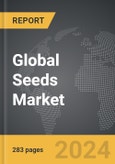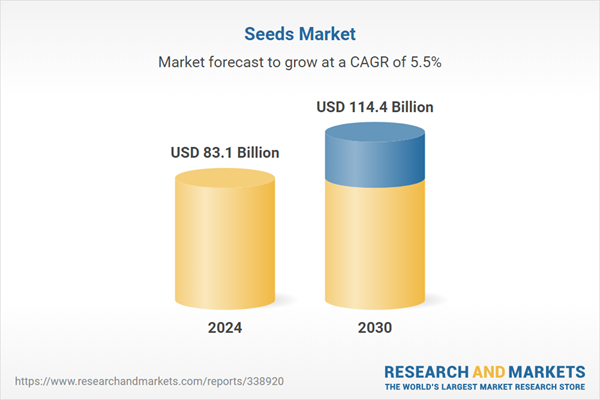The global market for Seeds was valued at US$83.1 Billion in 2024 and is projected to reach US$114.4 Billion by 2030, growing at a CAGR of 5.5% from 2024 to 2030. This comprehensive report provides an in-depth analysis of market trends, drivers, and forecasts, helping you make informed business decisions. The report includes the most recent global tariff developments and how they impact the Seeds market.
The primary driver for the growth of the seed industry is the increasing demand for agricultural productivity. With the global population projected to reach 9.7 billion by 2050, the demand for food and agricultural products is surging. This demand pushes for higher yields and more efficient farming practices, where high-quality seeds play a pivotal role. Many governments worldwide are supporting agricultural development through subsidies, grants, and research funding, recognizing the sector's importance for national food security. Such initiatives encourage the adoption of modern farming technologies, including the use of genetically modified (GM) seeds, further driving the growth of the seed industry.
The seed industry is at the forefront of addressing global challenges related to food security and sustainable agriculture. Driven by technological innovations, government support, and shifts towards organic and urban farming, the industry is poised for continued growth. Growth is primarily fueled by genetic enhancements and improvements in seed quality. Future seeds are expected not only to yield more but also to possess greater tolerance to biotic and abiotic stresses, which is crucial in facing the challenges posed by climate change. Innovations such as advanced molecular tools and gene editing are anticipated to drive precision breeding, enhancing the overall quality and efficiency of seeds.
Key drivers and trends in the seed industry include genetic and quality enhancements, hybrid seed production innovations, expansion of organic farming, climate-adaptive seeds, the rise of urban agriculture, precision agriculture, and seed treatment innovations. These advancements aim to optimize seed production, improve crop yields, and address challenges posed by climate change, urbanization, and evolving consumer preferences for organic products. Government support further accelerates industry growth, fostering the adoption of modern farming technologies worldwide.
Segments: Crop Type (Cereals & Grains, Oilseeds & Pulses, Fruits & Vegetables, Other Crop Types); Type (Conventional, Genetically Modified); Trait (Herbicide-Tolerance (HT), Insect-Resistance (IR), Other Traits).
Geographic Regions/Countries: World; United States; Canada; Japan; China; Europe (France; Germany; Italy; United Kingdom; Spain; Russia; and Rest of Europe); Asia-Pacific (Australia; India; South Korea; and Rest of Asia-Pacific); Latin America (Argentina; Brazil; Mexico; and Rest of Latin America); Middle East (Iran; Israel; Saudi Arabia; United Arab Emirates; and Rest of Middle East); and Africa.
The analysts continuously track trade developments worldwide, drawing insights from leading global economists and over 200 industry and policy institutions, including think tanks, trade organizations, and national economic advisory bodies. This intelligence is integrated into forecasting models to provide timely, data-driven analysis of emerging risks and opportunities.
Seeds: Key Trends and Drivers
Seeds are fundamental for agricultural output, accounting for 20-25% of productivity. The effectiveness of other agricultural inputs like fertilizers, pesticides, and irrigation is intrinsically linked to the quality of seeds used. The global seed industry is crucial for agricultural productivity and food security. It has been experiencing significant growth due to a variety of factors, ranging from technological advancements to changes in global dietary patterns. The integration of advanced genetic tools, precision technologies, and innovative breeding techniques points to a future where seeds are not only productive but also resilient and adaptable to changing climates.The primary driver for the growth of the seed industry is the increasing demand for agricultural productivity. With the global population projected to reach 9.7 billion by 2050, the demand for food and agricultural products is surging. This demand pushes for higher yields and more efficient farming practices, where high-quality seeds play a pivotal role. Many governments worldwide are supporting agricultural development through subsidies, grants, and research funding, recognizing the sector's importance for national food security. Such initiatives encourage the adoption of modern farming technologies, including the use of genetically modified (GM) seeds, further driving the growth of the seed industry.
The seed industry is at the forefront of addressing global challenges related to food security and sustainable agriculture. Driven by technological innovations, government support, and shifts towards organic and urban farming, the industry is poised for continued growth. Growth is primarily fueled by genetic enhancements and improvements in seed quality. Future seeds are expected not only to yield more but also to possess greater tolerance to biotic and abiotic stresses, which is crucial in facing the challenges posed by climate change. Innovations such as advanced molecular tools and gene editing are anticipated to drive precision breeding, enhancing the overall quality and efficiency of seeds.
Key drivers and trends in the seed industry include genetic and quality enhancements, hybrid seed production innovations, expansion of organic farming, climate-adaptive seeds, the rise of urban agriculture, precision agriculture, and seed treatment innovations. These advancements aim to optimize seed production, improve crop yields, and address challenges posed by climate change, urbanization, and evolving consumer preferences for organic products. Government support further accelerates industry growth, fostering the adoption of modern farming technologies worldwide.
Report Scope
The report analyzes the Seeds market, presented in terms of units. The analysis covers the key segments and geographic regions outlined below.Segments: Crop Type (Cereals & Grains, Oilseeds & Pulses, Fruits & Vegetables, Other Crop Types); Type (Conventional, Genetically Modified); Trait (Herbicide-Tolerance (HT), Insect-Resistance (IR), Other Traits).
Geographic Regions/Countries: World; United States; Canada; Japan; China; Europe (France; Germany; Italy; United Kingdom; Spain; Russia; and Rest of Europe); Asia-Pacific (Australia; India; South Korea; and Rest of Asia-Pacific); Latin America (Argentina; Brazil; Mexico; and Rest of Latin America); Middle East (Iran; Israel; Saudi Arabia; United Arab Emirates; and Rest of Middle East); and Africa.
Key Insights:
- Market Growth: Understand the significant growth trajectory of the Cereals & Grains segment, which is expected to reach US$46.9 Billion by 2030 with a CAGR of a 6.7%. The Oilseeds & Pulses segment is also set to grow at 5.2% CAGR over the analysis period.
- Regional Analysis: Gain insights into the U.S. market, valued at $21.7 Billion in 2024, and China, forecasted to grow at an impressive 8.5% CAGR to reach $26.4 Billion by 2030. Discover growth trends in other key regions, including Japan, Canada, Germany, and the Asia-Pacific.
Why You Should Buy This Report:
- Detailed Market Analysis: Access a thorough analysis of the Global Seeds Market, covering all major geographic regions and market segments.
- Competitive Insights: Get an overview of the competitive landscape, including the market presence of major players across different geographies.
- Future Trends and Drivers: Understand the key trends and drivers shaping the future of the Global Seeds Market.
- Actionable Insights: Benefit from actionable insights that can help you identify new revenue opportunities and make strategic business decisions.
Key Questions Answered:
- How is the Global Seeds Market expected to evolve by 2030?
- What are the main drivers and restraints affecting the market?
- Which market segments will grow the most over the forecast period?
- How will market shares for different regions and segments change by 2030?
- Who are the leading players in the market, and what are their prospects?
Report Features:
- Comprehensive Market Data: Independent analysis of annual sales and market forecasts in US$ Million from 2024 to 2030.
- In-Depth Regional Analysis: Detailed insights into key markets, including the U.S., China, Japan, Canada, Europe, Asia-Pacific, Latin America, Middle East, and Africa.
- Company Profiles: Coverage of players such as AgReliant Genetics LLC, Bayer AG, Bejo Zaden B.V, Canterra Seeds, China National Seed Group Corporation and more.
- Complimentary Updates: Receive free report updates for one year to keep you informed of the latest market developments.
Some of the 226 companies featured in this Seeds market report include:
- AgReliant Genetics LLC
- Bayer AG
- Bejo Zaden B.V
- Canterra Seeds
- China National Seed Group Corporation
- DLF
- DLF Pickseed USA
- Dow AgroSciences LLC
- DuPont Pioneer
- Enza Zaden
- Gansu Dunhuang Seed Co. Ltd.
- Groupe Limagrain Holding SA
- Hefei Fengle Seed Co. Ltd.
- Hunan Xiangyan Seed Industry Co. Ltd.
- Krishidhan Seeds Private Ltd.
- KWS SAAT SE
- Land O'Lakes Inc.
- Lantmännen SW Seed AB
- Monsanto Company
- Mycogen Seeds
- Nuziveedu Seeds Ltd.
- Rasi Seeds (P) Ltd.
- Rijk Zwaan Zaadteelt en Zaadhandel B.V.
- Sakata Seed Corp.
- Syngenta AG
- Takii & Company Limited
- The Scotts Miracle-Gro Company
- UPL Limited
- Vilmorin & Cie
Tariff Impact Analysis: Key Insights for 2025
Global tariff negotiations across 180+ countries are reshaping supply chains, costs, and competitiveness. This report reflects the latest developments as of April 2025 and incorporates forward-looking insights into the market outlook.The analysts continuously track trade developments worldwide, drawing insights from leading global economists and over 200 industry and policy institutions, including think tanks, trade organizations, and national economic advisory bodies. This intelligence is integrated into forecasting models to provide timely, data-driven analysis of emerging risks and opportunities.
What’s Included in This Edition:
- Tariff-adjusted market forecasts by region and segment
- Analysis of cost and supply chain implications by sourcing and trade exposure
- Strategic insights into geographic shifts
Buyers receive a free July 2025 update with:
- Finalized tariff impacts and new trade agreement effects
- Updated projections reflecting global sourcing and cost shifts
- Expanded country-specific coverage across the industry
Table of Contents
I. METHODOLOGYII. EXECUTIVE SUMMARY2. FOCUS ON SELECT PLAYERSIII. MARKET ANALYSISCANADAITALYSPAINRUSSIAREST OF EUROPESOUTH KOREAREST OF ASIA-PACIFICARGENTINABRAZILMEXICOREST OF LATIN AMERICAIRANISRAELSAUDI ARABIAUNITED ARAB EMIRATESREST OF MIDDLE EASTIV. COMPETITION
1. MARKET OVERVIEW
3. MARKET TRENDS & DRIVERS
4. GLOBAL MARKET PERSPECTIVE
UNITED STATES
JAPAN
CHINA
EUROPE
FRANCE
GERMANY
UNITED KINGDOM
ASIA-PACIFIC
AUSTRALIA
INDIA
LATIN AMERICA
MIDDLE EAST
AFRICA
Companies Mentioned (Partial List)
A selection of companies mentioned in this report includes, but is not limited to:
- AgReliant Genetics LLC
- Bayer AG
- Bejo Zaden B.V
- Canterra Seeds
- China National Seed Group Corporation
- DLF
- DLF Pickseed USA
- Dow AgroSciences LLC
- DuPont Pioneer
- Enza Zaden
- Gansu Dunhuang Seed Co. Ltd.
- Groupe Limagrain Holding SA
- Hefei Fengle Seed Co. Ltd.
- Hunan Xiangyan Seed Industry Co. Ltd.
- Krishidhan Seeds Private Ltd.
- KWS SAAT SE
- Land O'Lakes Inc.
- Lantmännen SW Seed AB
- Monsanto Company
- Mycogen Seeds
- Nuziveedu Seeds Ltd.
- Rasi Seeds (P) Ltd.
- Rijk Zwaan Zaadteelt en Zaadhandel B.V.
- Sakata Seed Corp.
- Syngenta AG
- Takii & Company Limited
- The Scotts Miracle-Gro Company
- UPL Limited
- Vilmorin & Cie
Table Information
| Report Attribute | Details |
|---|---|
| No. of Pages | 283 |
| Published | April 2025 |
| Forecast Period | 2024 - 2030 |
| Estimated Market Value ( USD | $ 83.1 Billion |
| Forecasted Market Value ( USD | $ 114.4 Billion |
| Compound Annual Growth Rate | 5.5% |
| Regions Covered | Global |









